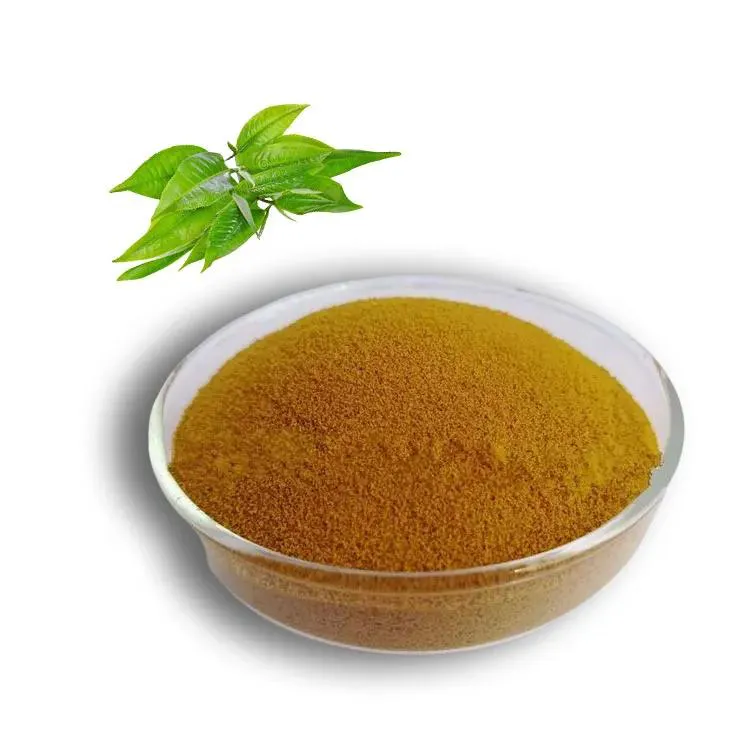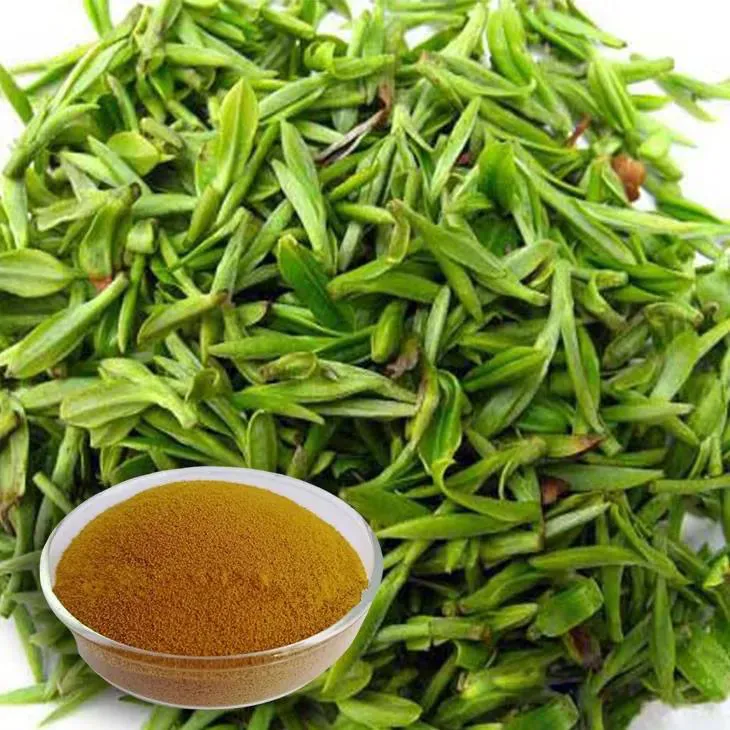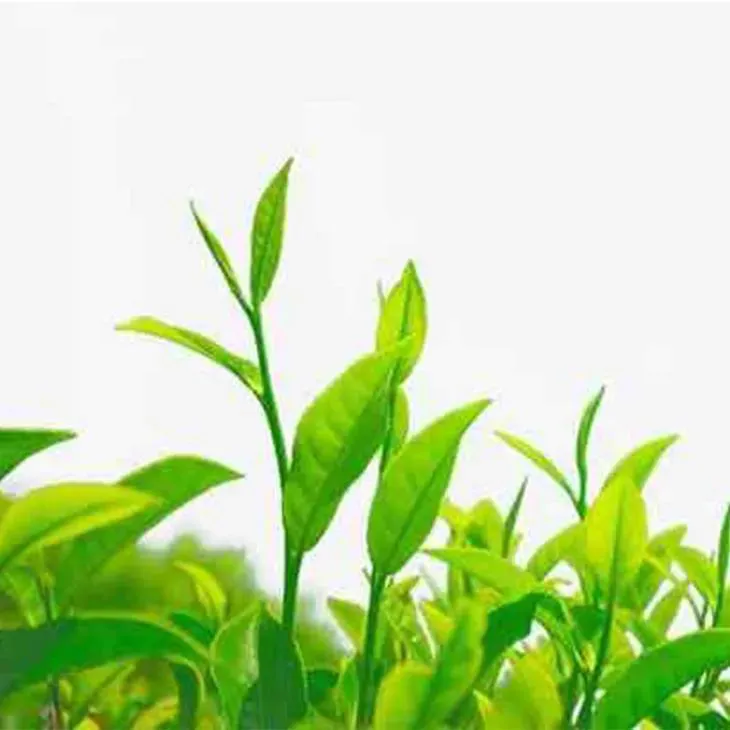- 0086-571-85302990
- sales@greenskybio.com
The process of extracting tea polyphenols from green tea extract.
2024-11-28

1. Introduction
Green tea has been renowned for its health - promoting properties for centuries. Among the various bioactive components in green tea, tea polyphenols stand out as one of the most important ones. Tea polyphenols possess antioxidant, anti - inflammatory, anti - cancer, and many other beneficial properties. Therefore, the extraction of tea polyphenols from Green Tea Extract has become an area of great interest in various fields such as medicine, food, and cosmetics.

2. Preparation of Green Tea Extract
2.1 Selection of raw materials
The quality of green tea leaves used for extraction is crucial. High - quality green tea leaves, preferably fresh and from reliable sources, should be selected. Different varieties of green tea, such as Longjing, Biluochun, and Maofeng, may have different levels of tea polyphenols. For example, some early - season green teas may contain relatively higher levels of tea polyphenols.
2.2 Pretreatment of green tea leaves
Before extraction, the green tea leaves need to be pretreated. This usually includes steps such as cleaning to remove dirt and impurities, and drying to reduce the moisture content. Drying can be carried out using natural drying methods, such as sun - drying, or mechanical drying methods in a controlled environment. The moisture content should be reduced to an appropriate level, usually around 3 - 5%, to ensure the efficiency of the subsequent extraction process.
2.3 Grinding of green tea leaves
Grinding the dried green tea leaves into a fine powder can increase the surface area available for extraction. This can be done using a grinder or a milling machine. The particle size of the ground green tea powder should be as small as possible, but not too fine to avoid clogging during extraction. A suitable particle size range could be around 20 - 50 micrometers.
3. Extraction methods
3.1 Aqueous extraction
- Aqueous extraction is one of the most common methods for extracting tea polyphenols from Green Tea Extract.
- The ground green tea powder is mixed with water at a certain ratio. A typical ratio could be 1:10 - 1:20 (green tea powder: water by weight). The mixture is then stirred continuously at a suitable temperature, usually in the range of 50 - 80°C. Stirring helps to ensure that the tea polyphenols are evenly dissolved in the water.
- The extraction time also plays an important role. It can range from 30 minutes to several hours. Longer extraction times may lead to higher yields of tea polyphenols, but it may also increase the extraction of other unwanted substances.
- After extraction, the mixture is filtered to separate the liquid extract containing tea polyphenols from the solid residue. Filtration can be carried out using filter papers, filters with different pore sizes, or centrifugal filtration methods.
3.2 Organic solvent extraction
- Organic solvents such as ethanol, methanol, and ethyl acetate can also be used for the extraction of tea polyphenols.
- When using organic solvents, the ground green tea powder is soaked in the organic solvent. The solvent concentration and the ratio of solvent to green tea powder need to be carefully controlled. For example, when using ethanol, a concentration of 50 - 70% ethanol and a ratio of 1:5 - 1:10 (green tea powder: ethanol by volume) may be used.
- The extraction process is usually carried out at room temperature or with gentle heating. However, excessive heating should be avoided as it may cause the degradation of tea polyphenols.
- Similar to aqueous extraction, after extraction, the mixture is filtered to obtain the organic solvent extract containing tea polyphenols. The solvent in the extract may need to be removed in a subsequent step, usually by evaporation under reduced pressure.

4. Refinement operations
4.1 Chromatography
- Chromatography is a very effective method for further refining the tea polyphenol extract to achieve high - purity tea polyphenols.
- High - performance liquid chromatography (HPLC) is commonly used. In HPLC, the tea polyphenol extract is injected into a column filled with a stationary phase. Different components in the extract will have different affinities for the stationary phase and the mobile phase (usually a solvent), and thus will be separated as they pass through the column.
- By adjusting the parameters such as the type of stationary phase, the composition of the mobile phase, and the flow rate, different tea polyphenols can be separated and purified. For example, catechins, which are the main components of tea polyphenols, can be separated from other minor components.
4.2 Precipitation
- Precipitation is another method for refining tea polyphenols. By adding certain reagents to the tea polyphenol extract, some impurities can be made to precipitate out.
- For example, by adding metal salts such as calcium chloride, some acidic impurities in the extract may form insoluble salts and precipitate. Then, the precipitate can be removed by filtration, leaving a relatively purer tea polyphenol solution.
5. Quality control and analysis
5.1 Determination of tea polyphenol content
- There are several methods for determining the tea polyphenol content in the final product. One of the most common methods is the Folin - Ciocalteu assay.
- In the Folin - Ciocalteu assay, the tea polyphenol sample reacts with the Folin - Ciocalteu reagent, and the resulting color change is measured spectrophotometrically. The intensity of the color is proportional to the amount of tea polyphenols present.
5.2 Identification of tea polyphenol components
- To fully understand the quality of the extracted tea polyphenols, it is necessary to identify the different components present. Techniques such as HPLC - mass spectrometry (HPLC - MS) can be used.
- HPLC - MS combines the separation ability of HPLC with the identification ability of mass spectrometry. It can accurately identify different tea polyphenol components, such as different catechins (epicatechin, epigallocatechin, etc.) and their derivatives.
6. Applications of extracted tea polyphenols
6.1 In the medical field
- Tea polyphenols have shown potential in the prevention and treatment of various diseases. For example, their antioxidant properties can help to prevent oxidative stress - related diseases such as cardiovascular diseases.
- Some studies have also suggested that tea polyphenols may have anti - cancer effects. They may be able to inhibit the growth and proliferation of cancer cells by interfering with certain signaling pathways.
6.2 In the food industry
- Tea polyphenols can be used as natural preservatives in the food industry. They can inhibit the growth of bacteria, yeasts, and molds, thereby extending the shelf life of food products.
- They are also added to some functional foods as health - promoting ingredients. For example, in green tea - flavored beverages, tea polyphenols not only contribute to the flavor but also provide health benefits.
6.3 In the cosmetics industry
- In the cosmetics industry, tea polyphenols are used for their antioxidant and anti - aging properties. They can help to protect the skin from damage caused by free radicals, reducing wrinkles and improving skin elasticity.
- They are also added to some hair care products to improve hair health, such as reducing hair loss and promoting hair growth.
7. Conclusion
The extraction of tea polyphenols from green tea extract is a complex but important process. Through proper selection of raw materials, appropriate extraction methods, and effective refinement operations, high - quality tea polyphenols can be obtained. These tea polyphenols have wide applications in various fields, which further emphasizes the significance of the extraction process. With the continuous development of research and technology, it is expected that more efficient and environmentally friendly extraction methods will be developed in the future, enabling better utilization of tea polyphenols.
FAQ:
What are the main methods for extracting green tea extract?
The main methods for extracting green tea extract include aqueous extraction and organic solvent extraction. Aqueous extraction uses water as the solvent to extract components from green tea. Organic solvent extraction, on the other hand, employs organic solvents such as ethanol to extract the desired substances from the tea.
Why is chromatography often used in the process of extracting tea polyphenols?
Chromatography is often used in the extraction of tea polyphenols because it can effectively separate and purify the components. Tea polyphenols need to be highly purified for various applications. Chromatography can separate different substances in the extract based on their different affinities to the stationary and mobile phases, thus obtaining high - purity tea polyphenols.
What health - promoting properties do tea polyphenols have?
Tea polyphenols have several health - promoting properties. They are antioxidants, which can help neutralize free radicals in the body and reduce oxidative stress. They may also have anti - inflammatory effects, be beneficial for heart health by reducing cholesterol levels, and potentially play a role in preventing certain types of cancer.
How does the extraction method affect the quality of tea polyphenols?
Different extraction methods can affect the quality of tea polyphenols in various ways. For example, the choice of solvent in extraction can influence the purity and composition of the extracted tea polyphenols. Aqueous extraction may result in a different profile of tea polyphenols compared to organic solvent extraction. Additionally, improper extraction conditions such as excessive heat or long extraction times in some methods might lead to the degradation of tea polyphenols, reducing their quality.
Can the extraction process of tea polyphenols be optimized?
Yes, the extraction process of tea polyphenols can be optimized. This can be achieved by carefully selecting the extraction method and parameters. For example, adjusting the solvent type, concentration, extraction time, temperature, and ratio of tea to solvent can all potentially improve the extraction efficiency and the quality of the extracted tea polyphenols. Additionally, the combination of different extraction and purification methods may also lead to better results.
Related literature
- Extraction and Analysis of Tea Polyphenols from Green Tea"
- "Optimization of Tea Polyphenol Extraction from Green Tea: A Review"
- "The Role of Chromatography in Purifying Tea Polyphenols from Green Tea Extract"
- ▶ Hesperidin
- ▶ citrus bioflavonoids
- ▶ plant extract
- ▶ lycopene
- ▶ Diosmin
- ▶ Grape seed extract
- ▶ Sea buckthorn Juice Powder
- ▶ Beetroot powder
- ▶ Hops Extract
- ▶ Artichoke Extract
- ▶ Reishi mushroom extract
- ▶ Astaxanthin
- ▶ Green Tea Extract
- ▶ Curcumin Extract
- ▶ Horse Chestnut Extract
- ▶ Other Problems
- ▶ Boswellia Serrata Extract
- ▶ Resveratrol Extract
- ▶ Marigold Extract
- ▶ Grape Leaf Extract
- ▶ blog3
- ▶ blog4
-
Organic Cranberry Extract Powder Factory.
2024-11-28
-
Nature's Bounty Açai Extract.
2024-11-28
-
100% Pure Natural Passion Fruit Extract.
2024-11-28
-
100% Organic Tongkat Ali Extract Powder.
2024-11-28
-
Organic honeysuckle pollen powder factory.
2024-11-28
-
Black Rice Extract
2024-11-28
-
Aminolevulinic acid
2024-11-28
-
Mango flavored powder
2024-11-28
-
Cassia Seed Extract
2024-11-28
-
Golden Seal Extract
2024-11-28
-
Genistein
2024-11-28
-
Okra Extract
2024-11-28
-
Shikonin
2024-11-28
-
Phyllanthus Emblica Extract
2024-11-28
-
Hedyotis Diffusa Extract
2024-11-28





















